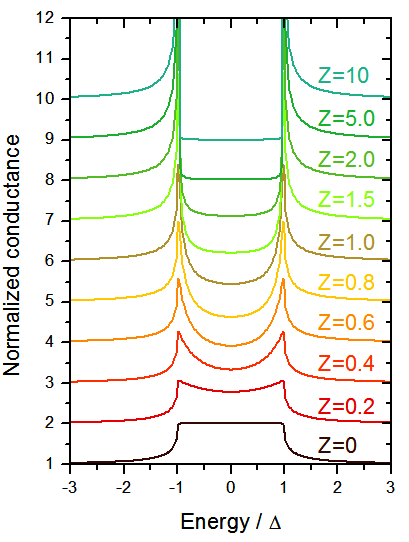 | Laboratory of Theoretical and Experimental Superconductive Tunnelling |
| Home | Publications | Equipments | Projects | People | Join us | Links |
Fundamental study of unconventional superconductors | Experimental techniques Point-contact spectrosopy is a simple but powerful experimental technique that allows directly measuring the energy gap in a superconductor, and to determine its symmetry in the reciprocal space, thanks to quantum phenomena that occur at the interface between the superconductor and a normal metal. A point contact (i.e. a contact whose radius is smaller than the electronic mean free path and of the coherence length in the superconductor) is made between a normal metal (N) and the superconductor under study (S). This is achieved for example by pressing a very sharp metallic tip against the sample surface, as in the standard "needle-anvil" tecnique. We actually developed a pressure-less, "soft" technique in which the contact is made by putting a small dro of Ag conductive paint on the sample surface. This has some advantages in very small (or thin) samples, and ensures greater mechanical and thermal stability.
| Contact configuration in the "soft" PCS technique Sketch of the trajectories of quasiparticles involved in Andreev reflection at the N/S interface  Calculated point-contact spectra for the case of a single-gap, s-wave superconductor, from the pure Andreev regime (SN junction, Z=0) to the pure tunnel regime (SIN junction, Z=10) |
| The Josephson effect
is due to the tunneling of Cooper pairs between two superconductors.
SIS or SIS' junctions whose conductance is dominated by quasiparticle
tunnelling and Cooper pair tunnellingcan be obtained by using the
point-contact technique (if the tip is made of a superconductor) or the
break-junction
technique. In this case, a sample of the superconductor under study is
broken at low temperature in two parts that are then are then
readjusted until a weak link is formed between them. Under irradiation
with microwaves, these junctions can show the Shapiro steps typical of
the inverse ac Josephson effect. | I-V characteristics of a Josephson break junction in MgB2 | |
| Transport measurements
in low-resistance materials are carried out by using the four-probe
configuration, eliminating thermoelectric effects and applying suitable
corrections for anisotropic or layered materials. Depending on the shape of the sample under study and on the purpose of the measure, different contact configurations are used: standard (for regularly shaped bulk materials or patterned films), collinear (for films or thin samples), van der Pauw (for films or thin samples of irregular shape), Montgomery (for large single crystals). |  Resistance of a Ba(Fe,Co)2As2 thin film (measured with the van der Pauw method) | |
| LaTEST - Department of Applied Science and Technology, Politecnico di Torino corso Duca degli Abruzzi 24, 10129 Torino (TO) - Italy  |